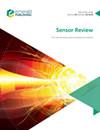基于恒温法的热气流传感器设计及温度补偿研究
IF 1.4
4区 工程技术
Q3 INSTRUMENTS & INSTRUMENTATION
引用次数: 0
摘要
目的针对典型的热式气流传感器功耗高、集成困难的问题,基于FS5热元件和恒温测量方法,研制出一种测量精度高、功耗低、体积小、成本低、易于系统集成的流量传感器。设计/方法/方法使用小型风洞测试和评估传感器的测量范围、反应时间、稳定性、可重复性、测量精度,并在−10°C至30°C的温度范围内进行多温度校准。研究了环境温度对传感器测量数据的影响,并研究了幂函数的系数校正方法来实现传感器的软件温度补偿功能。结果表明,该传感器稳定、可重复,输出电压与流量呈幂函数关系,流量测量范围为0–18 m/s,响应时间小于3 s、 高流速下的测量精度在0.4以内 m/s,并且温度校正的气流速率测量误差小于5%。将温度校准间隔设置为2°C和5°C具有相同的温度补偿效果,显著减少了传感器的校准工作量。独创性/价值本文证明了使用恒温方法构建热风速传感器,该传感器在0–18的风速测量范围内提供准确的测量结果 m/s。此外,还对传感器的性能进行了评估,并对各种温度范围进行了校准测试。最后,在功率函数校正方法的基础上,提出了一种温度补偿算法。本文章由计算机程序翻译,如有差异,请以英文原文为准。
Thermal airflow sensor design and temperature compensation research based on the thermostatic method
Purpose
This paper aims to solve the typical thermal airflow sensor's high power consumption and integration difficulties, based on the FS5 thermal element and constant temperature measurement method, a flow sensor is developed with high measurement accuracy, low power consumption, small size, low cost and easy system integration.
Design/methodology/approach
A small wind tunnel was used to test and assess the sensor's measurement range, reaction time, stability, repeatability, measurement accuracy and multi-temperature calibration was performed in the temperature range of −10°C to 30°C. The effect of ambient temperature on the sensor's measurement data is investigated, and the coefficient correction method of power function was investigated to implement the sensor's software temperature compensation function.
Findings
The results show that the sensor is stable and repeatable, the output voltage has a power function relationship with the airflow rate, the flow rate measurement range is 0–18 m/s, the response time is less than 3 s, the measurement accuracy at high flow rates is within 0.4 m/s and the temperature-corrected airflow rate measurement error is less than 5%. Setting the temperature calibration interval to 2°C and 5°C has the same temperature compensation effect, reducing the sensor's calibration effort significantly.
Originality/value
This paper demonstrates that a thermostatic method is used to construct a thermal wind speed sensor that delivers accurate measurements in the wind speed measuring range of 0–18 m/s under test conditions. In addition, the sensor's performance is evaluated, and calibration tests for a wide range of temperatures are done. Finally, based on the power function correction method, a temperature compensation algorithm is proposed.
求助全文
通过发布文献求助,成功后即可免费获取论文全文。
去求助
来源期刊

Sensor Review
工程技术-仪器仪表
CiteScore
3.40
自引率
6.20%
发文量
50
审稿时长
3.7 months
期刊介绍:
Sensor Review publishes peer reviewed state-of-the-art articles and specially commissioned technology reviews. Each issue of this multidisciplinary journal includes high quality original content covering all aspects of sensors and their applications, and reflecting the most interesting and strategically important research and development activities from around the world. Because of this, readers can stay at the very forefront of high technology sensor developments.
Emphasis is placed on detailed independent regular and review articles identifying the full range of sensors currently available for specific applications, as well as highlighting those areas of technology showing great potential for the future. The journal encourages authors to consider the practical and social implications of their articles.
All articles undergo a rigorous double-blind peer review process which involves an initial assessment of suitability of an article for the journal followed by sending it to, at least two reviewers in the field if deemed suitable.
Sensor Review’s coverage includes, but is not restricted to:
Mechanical sensors – position, displacement, proximity, velocity, acceleration, vibration, force, torque, pressure, and flow sensors
Electric and magnetic sensors – resistance, inductive, capacitive, piezoelectric, eddy-current, electromagnetic, photoelectric, and thermoelectric sensors
Temperature sensors, infrared sensors, humidity sensors
Optical, electro-optical and fibre-optic sensors and systems, photonic sensors
Biosensors, wearable and implantable sensors and systems, immunosensors
Gas and chemical sensors and systems, polymer sensors
Acoustic and ultrasonic sensors
Haptic sensors and devices
Smart and intelligent sensors and systems
Nanosensors, NEMS, MEMS, and BioMEMS
Quantum sensors
Sensor systems: sensor data fusion, signals, processing and interfacing, signal conditioning.
 求助内容:
求助内容: 应助结果提醒方式:
应助结果提醒方式:


